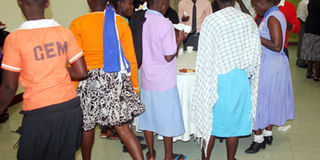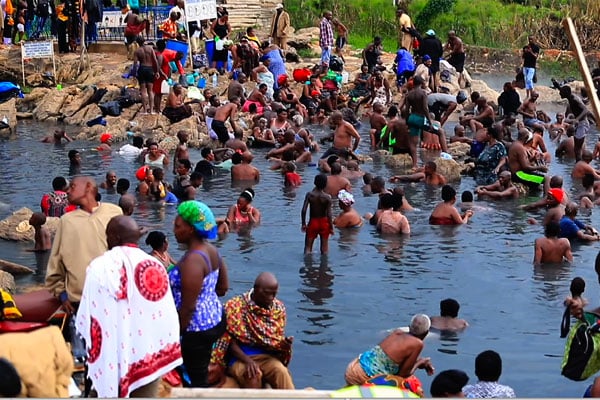Prime
Why we observe 16 days of activism

Students at a workshop on stopping teenage pregnancies and forced marriage. This year’s 16 Days of Activism campaign is against teenage pregnancies and forced marriages. FILE
What you need to know:
Every year, we observe 16 Days of Activism from November 25 to December 10. We take a look at why that time frame was earmarked and what it aims to achieve.
On November 25, 1960, three sisters; Patria, Minerva, and Maria Teresa Mirabal, were murdered on the orders of the President of the Dominican Republic, Rafael Trujillo Molina.
The sisters and their husbands were leading figures in a movement to bring democracy to the country. On October 19, 1999 the UN representative of the Dominican Republic introduced a draft resolution calling for the designation of November 25 as the International Day for the Elimination of Violence Against Women. To this day, that date is observed worldwide.
In light of the three sisters’ story, every year from November 25 to December 10, sixteen Days of Activism are observed. Since 1991, approximately 1,700 organisations in 130 countries have participated in the 16 Days Campaign. Uganda is one of the countries that takes part in the campaign.
Every year, the campaign has a different theme, globally, continentally and nationally. This year, Uganda’s theme is “Act Now, Stop Teenage Pregnancies Child and Forced Marriages.”
Highlights of the 16 days
Broadly expanded as The 16 Days of Activism Against Gender Violence, Tina Musuya; Executive Director of Center for Domestic Violence Prevention (Cedovip) defines it as an international campaign originating from the first Women’s Global Leadership Institute sponsored by the Center for Women’s Global Leadership in 1991.
With Cedovip taking part in this campaign since its existence in 2003, Musuya says the highlights of this campaign are; December 1, which is World Aids Day; December 3, International Day of the Disabled ; December 6, anniversary of the Montreal Massacre, and December 10 – World Human Rights Day.
Perhaps the unfamiliar days are December 6 and December 10. Musuya explains December 6 as the day the women fraternity commemorates the deaths of 14 young female engineering students who were shot dead at Montreal University in Canada in 1989.
The gunman opened fire in two classrooms and the cafeteria after ordering 48 men in the room to leave. Before opening fire, the gunman shouted “You’re all a bunch of feminists, and I hate feminists!”
December 10 is an important day in the campaign because it the anniversary of the Universal Declaration of Human Rights, proclaimed in 1948. Article 2 of the Declaration proclaims “everyone is entitled to all the rights and freedoms set forth in this Declaration without distinction of any kind such as race, colour, sex…..”
This action played a vital role at the 1993 Vienna World Conference on Human Rights in recognising violence against women as a human rights violation. The Conference drafted a Declaration to this effect and appointed the Special Rapporteur on violence against women.
What happens during the 16 days
Musuya explains that so many activities take place during the campaign. They include demonstration marches, public events such as drama, dialogues, and sporting events, training of law enforcers, policy makers, journalists, community members and judicial officers to raise awareness about GBV and to call for action against GBV.
“Other things that the campaign emphasises are elimination of all forms of violence against women which include: raising awareness about gender-based violence as a human rights, issue at the local, national, regional and international level.
Strengthening local work around violence against women, establishing a clear link between local and international work to end violence against women,” she adds.
Others are providing a forum in which organisers can develop and share new and effective strategies, demonstrating the solidarity of women around the world organising against violence against women and creating tools to pressure governments to implement promises made to eliminate violence against women. This year, stakeholders are strongly advocating for another discussion on the Marriage and Divorce Bill.
How effective has the campaign been?
So far, the implementers of the campaign boast of attracting government attention and commitment to addressing GBV through enactment of laws such as the Domestic Violence Act, Anti Female Genital Mutilation Act, and Anti Trafficking in Persons Act. This therefore means that there is legal protection of victims and apprehension of suspects.
Other achievements are possession of a national GBV action plan being implemented through Ministry of Gender, Labour and Social Development prevention programmes for example the GBV Joint program in Northern Uganda and GBV joint program in Busoga to prevent violence against women.
“Ministry of Health and the police are all developing their training curriculum to include developing all their officers skills to respond to victims of GBV and also to provide services to GBV victims to ensure their safety,” Musuya says.
She adds that religious institutions such as the Catholic Church have instituted domestic violence prevention program into their church activities.
Communities in various regions of Uganda where many civil society organisations are implementing their work have taken lead in preventing violence against women and they ensure that the perpetrators are brought to book.
Challenges to be addressed
Musuya points out that while efforts have been made to raise awareness on the huge negative effects of domestic violence and the need for communities to report immediately to the relevant authority, several challenges continue to persist. These include the conviction rates remaining low, for which statistic, one would have to rely on court records; the institutions mandated to manage domestic violence cases are inadequately resourced, which frustrates speedy prosecution of cases and the weak enforcement mechanisms for the existing laws and polices remains a challenge.
Musuya says the health consequences of this violence are significant; women who have experienced violence are up to three times more likely to be infected with HIV than those who have not.
The effects of violence do not only have an impact on the health of the individual and the family but also the health of economies. The 2012 Cedovip report on the Economic Cost of Domestic Violence in Uganda indicates that the government loses an estimated Shs77bn every year to address domestic violence. Domestic Violence also remains a driver for the HIV/Aids prevalence reported at 7.4 per cent according to the Ministry of Health indicator survey 2011.
The amount government spends annually to address Gender based violence
77b




